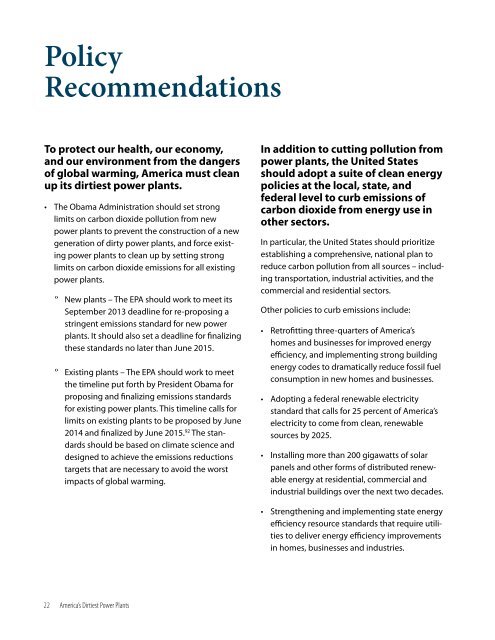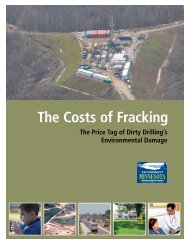America’s Dirtiest Power Plants
America's Dirtiest Power Plants - Environment Minnesota
America's Dirtiest Power Plants - Environment Minnesota
- No tags were found...
You also want an ePaper? Increase the reach of your titles
YUMPU automatically turns print PDFs into web optimized ePapers that Google loves.
Policy<br />
Recommendations<br />
To protect our health, our economy,<br />
and our environment from the dangers<br />
of global warming, America must clean<br />
up its dirtiest power plants.<br />
The Obama Administration should set strong<br />
limits on carbon dioxide pollution from new<br />
power plants to prevent the construction of a new<br />
generation of dirty power plants, and force existing<br />
power plants to clean up by setting strong<br />
limits on carbon dioxide emissions for all existing<br />
power plants.<br />
º New plants – The EPA should work to meet its<br />
September 2013 deadline for re-proposing a<br />
stringent emissions standard for new power<br />
plants. It should also set a deadline for finalizing<br />
these standards no later than June 2015.<br />
º Existing plants – The EPA should work to meet<br />
the timeline put forth by President Obama for<br />
proposing and finalizing emissions standards<br />
for existing power plants. This timeline calls for<br />
limits on existing plants to be proposed by June<br />
2014 and finalized by June 2015. 92 The standards<br />
should be based on climate science and<br />
designed to achieve the emissions reductions<br />
targets that are necessary to avoid the worst<br />
impacts of global warming.<br />
In addition to cutting pollution from<br />
power plants, the United States<br />
should adopt a suite of clean energy<br />
policies at the local, state, and<br />
federal level to curb emissions of<br />
carbon dioxide from energy use in<br />
other sectors.<br />
In particular, the United States should prioritize<br />
establishing a comprehensive, national plan to<br />
reduce carbon pollution from all sources – including<br />
transportation, industrial activities, and the<br />
commercial and residential sectors.<br />
Other policies to curb emissions include:<br />
Retrofitting three-quarters of <strong>America’s</strong><br />
homes and businesses for improved energy<br />
efficiency, and implementing strong building<br />
energy codes to dramatically reduce fossil fuel<br />
consumption in new homes and businesses.<br />
Adopting a federal renewable electricity<br />
standard that calls for 25 percent of <strong>America’s</strong><br />
electricity to come from clean, renewable<br />
sources by 2025.<br />
Installing more than 200 gigawatts of solar<br />
panels and other forms of distributed renewable<br />
energy at residential, commercial and<br />
industrial buildings over the next two decades.<br />
Strengthening and implementing state energy<br />
efficiency resource standards that require utilities<br />
to deliver energy efficiency improvements<br />
in homes, businesses and industries.<br />
22 <strong>America’s</strong> <strong>Dirtiest</strong> <strong>Power</strong> <strong>Plants</strong>



